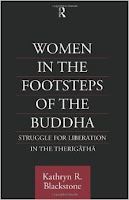Susan Elbaum Jootla (Buddhist Publication Society Wheel #349 via AccessToInsight.org) edited by Dhr. Seven, Ashley Wells, Crystal Quintero, CC Liu, Wisdom Quarterly
 |
| Tibetan nuns in the Himalayas, Ganden Jangchup Choeling nunnery (Reuters/dailymail.co.uk) |
 |
| The Buddha, a Scythian from the west who was enlightened in the East, opened the Path to enlightenment and liberation to everyone regardless of sex, race, class, caste, or wealth. |
 |
| Female + meditation = full enlightenment. |
Let's explore the sacred gathas, verses or songs,
composed by enlightened Buddhist nuns (arhat bhikkhunis and/or theris) from the time of the Buddha,
looking at them as springs of inspiration for contemporary
Buddhists.
Most of the verses are preserved in the Therigatha or "Psalms of the Sisters," a small section of the vast Pali language canon.
 |
| The Buddha ordained and taught nuns and female novices as well as monks (chandwimala). |
 |
| Therigatha (Dr. A. K. Singh) |
Quotations from both translations are used here, referring to Psalms of the Early Buddhists by page number and to The Elders' Verses
by verse number. Mrs. Rhys Davids' translations have sometimes been
slightly modified.
- Women and Buddhism: Suggested Reading (BuddhaNet)
 |
| Amazing Buddha Girl ordained in L.A. (WQ) |
This discussion also draws upon the verses of female ascetics from the Kindred Sayings (Samyutta Nikaya) included by Mrs. Rhys Davids at the end of Psalms of the Sisters.
From the sayings of some enlightened nuns at the time of the Buddha modern followers of the Noble Eightfold Path to enlightenment can receive a great
deal of instruction and inspiration, help and encouragement.
These verses can assist us
in developing and strengthening virtue, concentration, and liberating wisdom, the three divisions of
the Path to complete freedom (nirvana). With their aid we are able to play-and-work more effectively
towards eliminating mental defilements that hold us back life after life and towards finding lasting
peace and unshakeable happiness.
 |
| Our beloved California Buddhist nuns, like Ayya Tathaloka (shown here in center) from the Bay Area, with the help of progressive elder monks like Ven. Piyananda, helped reestablish the Theravada Nuns' Order known as the Bhikkhuni Sangha (bhikkhuni.net). |
 |
| Therigatha (K. Blackstone) |
In some respects, the inspiration we can gain from these verses may be stronger
for females than for males, since these are in fact women's voices speaking. (Males have an analogous text, Psalms of the Elders or Theragatha). And when the theme of the verses is the mother-child bond, this
is bound to be the case.
However, at a deeper level, the sex or gender of the
speakers is irrelevant. For the ultimate truths they articulate
explain universal principles of reality far beyond gender or other social constructs like race, socioeconomic status, beauty, age, and so on. They are equally valid for
males and females.
 |
| The "Lord of Death," rules samsara (rebirth). |
The verses of the nuns, if systematically examined, can help serious
Buddhist meditators understand many central aspects of the Dharma, the Teachings of the Buddha, which as a coherent Path again set in motion the Wheel of Timeless Truth.
The background to the verses, including biographical information on the
nuns who uttered the inspired songs, is provided by the ancient commentary on the Therigatha by the Venerable Acariya Dhammapala.
 |
| The First Buddhist Women |
Mrs. C.A.F. Rhys Davids included some of these background stories in Psalms of the Early Buddhists. In the first part of this essay we look at these stories and
consider the themes they suggest which are relevant to contemporary
students of Buddhist meditation.
Then we discuss a
selection of the verses themselves, which deal with many specific Teachings of the Buddha.
We in the 20th century who are seeking to attain enlightenment and final liberation will
find ourselves deeply grateful to these fully awakened Buddhist nuns of
the past for their profound assistance in illuminating the Dharma for us in
their own distinctly personal ways.
I. The Background Stories
 |
| Samsara, the frightful Wheel of Life and Death |
The ancient commentaries give us information about each nun's
background and also explain the verses themselves. Two major themes of
relevance to modern students of the Dharma run through these
stories.
One is the immeasurably long time that we -- as males and females, as light beings in blissful worlds and miserable beasts in worlds of woe and everything in between -- have all been lost in this samsara,
this Endless Round of Birth and Death.
 |
| Therigatha (Harvard) |




















































































































































































































































No comments:
Post a Comment